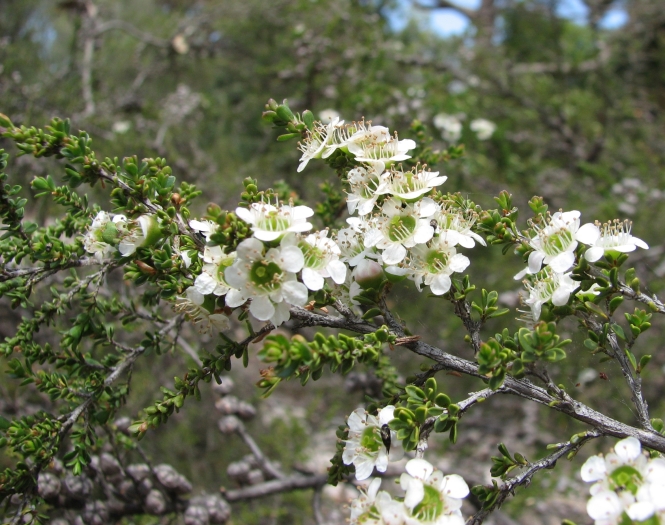Olive Tea-Tree
(Leptospermum liversidgei)
Olive Tea-Tree (Leptospermum liversidgei)
/
/

Melburnian
CC BY-SA 3.0
Image By:
Melburnian
Recorded By:
Copyright:
CC BY-SA 3.0
Copyright Notice:
Photo by: Melburnian | License Type: CC BY-SA 3.0 | License URL: https://creativecommons.org/licenses/by-sa/3.0 | Uploader: Melburnian | Publisher: Wikimedia Commons | Title: Leptospermum_liversidgei.jpg | Notes: |
































Estimated Native Range
Summary
Leptospermum liversidgei, commonly known as Olive Tea-tree, is a compact evergreen shrub native to coastal swamps and wet heathlands in eastern Australia. It typically grows to a height of 4 meters (13 feet) and features thin, rough bark on the main branches with hairy young stems. The narrow, egg-shaped leaves are lemon-scented, and the shrub produces white or pink flowers that are modest in size but can be quite numerous, creating a decorative effect. After flowering, woody fruit capsules remain on the plant. The Olive Tea-tree’s flowering season occurs in summer.
The Olive Tea-tree is valued for its aromatic foliage, which contains the essential oil citronellal, and its ability to tolerate poorly-drained soils and at least moderate frost, making it suitable for smaller gardens and urban landscapes. It is also used for its purported mosquito-repelling properties. In cultivation, it thrives in full sun and requires medium amounts of water with well-draining soil. While it is not particularly prone to diseases, root rot can occur in overly wet conditions. The plant’s manageable size and resilience to coastal conditions make it a popular choice for borders, hedges, and as a feature plant in water-sensitive landscapes.CC BY-SA 4.0
The Olive Tea-tree is valued for its aromatic foliage, which contains the essential oil citronellal, and its ability to tolerate poorly-drained soils and at least moderate frost, making it suitable for smaller gardens and urban landscapes. It is also used for its purported mosquito-repelling properties. In cultivation, it thrives in full sun and requires medium amounts of water with well-draining soil. While it is not particularly prone to diseases, root rot can occur in overly wet conditions. The plant’s manageable size and resilience to coastal conditions make it a popular choice for borders, hedges, and as a feature plant in water-sensitive landscapes.CC BY-SA 4.0
Plant Description
- Plant Type: Shrub
- Height: 15-20 feet
- Width: 5-10 feet
- Growth Rate: Moderate
- Flower Color: White
- Flowering Season: Summer
- Leaf Retention: Evergreen
Growth Requirements
- Sun: Full Sun
- Water: Medium
- Drainage: Fast
Common Uses
Bee Garden, Bird Garden, Butterfly Garden, Deer Resistant, Drought Tolerant, Fragrant, Low Maintenance, Rock Garden, Salt Tolerant, Street Planting
Natural Habitat
Coastal swamps and wet heathlands in eastern Australia
Other Names
Common Names: Lemon-Scented Tea Tree, Citron-Scent Teatree, Lemon-Scent Teatree
Scientific Names: , Leptospermum liversidgei, Leptospermum flavescens var. citriodorum, Leptospermum polygalifolium var. citriodorum,
GBIF Accepted Name: Leptospermum liversidgei R.T.Baker & H.G.Sm.